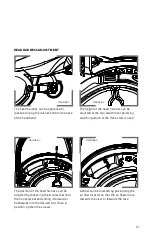
10
EMPLOYER RESPONSIBILITIES
Your specific responsibilities may vary by location and industry, but in general RPB
®
expects that
employers will:
Follow all applicable standards and regulations for your location, industry, and activity.
Depending on your location and industry, a number of standards and regulations may
apply to your selection and use of respirators and other personal protective equipment.
These may include such things as federal, local, or military standards and regulations and
consensus standards such as EN and AN/NZS. There are also requirements specific to
particular contaminants, e.g. silica (see rpbsafety.com/importantsafetyinformation/ for more
information), asbestos, organic pathogens, etc. Know which requirements apply to your
location and industry.
Have appropriate safety programs in place.
Have and follow:
A workplace safety program.
A written respiratory protection program in accordance with applicable standards and
regulations.
In accordance with the above
,
Perform a hazard analysis and select appropriate equipment for each activity.
A hazard
analysis should be performed by a qualified person. Controls should be in place as
appropriate and a qualified person should determine what kind of respiratory, face
and eye, head, and hearing protection is appropriate for the intended activities and
environments of use. (For example, select a respirator appropriate to the specific airborne
hazards, with consideration of workplace and user factors and with a Nominal Protection
Factor that meets or exceeds the required level for employee protection, select welding
face and eye protection appropriate to the type of welding to be done, etc.)
As applicable, check your workplace safety program, respiratory protection program, and
standards and regulations for your activity or industry for related protection requirements,
and see this manual (Protection Provided and Limitations, page 4) and the PX4 AIR
®
PAPR or flow control device Instruction Manual for product specifications.
Be sure employees are medically qualified to use a respirator.
Have a qualified physician or other licensed health care professional (PLHCP) perform
medical evaluations using a medical questionnaire or an initial medical examination.
Train employees in the Z-LINK
®
’s use, maintenance, and limitations.
Appoint a qualified individual who is knowledgable about the RPB
®
Z-LINK
®
to provide
training:
Qualifications of the Respirator Trainer. Anyone providing respirator training shall:
a) be knowledgable in the application and use of the respirator(s);
b) have practical knowledge in the selection and use of respirator(s) and work practices
at the site;
c) have an understanding of the site’s respirator program; and
d) be knowledgable of applicable regulations.






























